FDTD Simulations for Rhodium and Platinum Nanoparticles for UV Plasmonics
Abstract
1. Introduction
2. Computational Algorithm
- Number of layers (for PML domain discretization purposes): 8;
- KAPPA, SIGMA, ALPHA (absorptive properties of PML regions kappa, sigma and alpha are estimated within the PML regions using polynomial functions) kappa = 2, sigma = 1, alpha = 0;
- Polinom (defines the order of the polynomial used to evaluate kappa and sigma): 3;
- Alpha-polynomial (defines the order of the polynomial used to evaluate the alpha channel): 1;
- Minimum and maximum number of layers (these provide an acceptable range of values for the number of PML layers). Minimum number of layers = 8, maximum number of layers = 64.
3. Simulation Results and Discussion
3.1. Ag Single Sphere NPs and Surfaces Consisting of Ag Hemispheres
3.2. Rh, Pt Single Spheres NPs and Surfaces Consisting of Rh, Pt Hemisphere
3.3. Ag single Hexagons NPs and Surfaces Consisting of Ag Hexagons
3.4. Au Single Star NPs and Surfaces Consisting of Ag Stars
4. Conclusions
Author Contributions
Funding
Institutional Review Board Statement
Informed Consent Statement
Data Availability Statement
Conflicts of Interest
Appendix A
- clear;
- closeall;
- script conversion to the second degree of the maximum values of the electric field strength
- #get the electric intensity
- exz=pinch(getelectric(“XZ”));
- eyz=pinch(getelectric(“YZ”));
- #find the maximum
- mxz=max((exz)^2);
- myz=max((eyz)^2);
- # get some raw (data numerical values obtained as a matrix on the axes)
- x1=getdata(“XZ”,”x”);
- z1=getdata(“XZ”,”z”);
- y2=getdata(“YZ”,”y”);
- z2=getdata(“YZ”,”z”);
- f=getdata(“YZ”,”f”);
- # [finding the gain (EF and intensity) through the calculation of the maximum values in the matrix]
- EFxz=exz^2;#enhancement factor
- index = find(EFxz,mxz);
- # convert index to row, col indices (finding numerical values by accessing indices at grid nodes)
- matrix_size = size(EFxz);
- indices = matrix(length(matrix_size));
- # do for each dimension
- for (i = 1:length(matrix_size)) {
- mod_dividend = index;
- mod_divisor = matrix_size(i);
- mod_remainder = mod(mod_dividend,mod_divisor);
- if (mod_remainder == 0) { mod_remainder = matrix_size(i); }
- indices(i) = mod_remainder;
- # remove this dimension from further calculations
- index = (index+(matrix_size(i)-mod_remainder))/matrix_size(i);
- }
- ?”max at x1 =“+num2str(x1(indices(1))*1e6)+” um”;
- ?”multi indice access: EF factor xz (“+num2str(indices(1))+”,”+
- num2str(indices(2))+”,”+
- num2str(indices(3))+”)=“+
- num2str(EFxz(indices(1),indices(2),indices(3)));
- # users may need to modify those values in order to have proper view of the resulting images (image size)
- zmin=-200e-9;
- zmax= 200e-9;
- xym = 150e-9;
- #
- nx1=find(x1,-xym)-1;
- nx2=find(x1, xym)+1;
- nz1=find(z1,zmin)-1;
- nz2=find(z1,zmax)+1;
- image(x1(nx1:nx2)*1e9,z1(nz1:nz2)*1e9,EFxz(nx1:nx2,nz1:nz2,indices(3)),”x nm”,”z nm”,”EF xz”);
- image(x1(nx1:nx2)*1e9,z1(nz1:nz2)*1e9,exz(nx1:nx2,nz1:nz2,indices(3)),”z nm”,”z nm”,”Intensity xz”);
- # in another cross section (the same actions for the plane YZ)
- EFyz=eyz^2;
- index = find(EFyz,myz);
- # convert index to row, col indices
- matrix_size = size(EFyz);
- indices = matrix(length(matrix_size));
- # do for each dimension
- for (i = 1:length(matrix_size)) {
- mod_dividend = index;
- mod_divisor = matrix_size(i);
- mod_remainder = mod(mod_dividend,mod_divisor);
- if (mod_remainder == 0) { mod_remainder = matrix_size(i); }
- indices(i) = mod_remainder;
- # remove this dimension from further calculations
- index = (index+(matrix_size(i)-mod_remainder))/matrix_size(i);
- }
- ?”multi indice access: EF factor yz (“+num2str(indices(1))+”,”+
- num2str(indices(2))+”,”+
- num2str(indices(3))+”)=“+
- num2str(EFyz(indices(1),indices(2),indices(3)));
- ?”max at y1 =“+num2str(y2(indices(1))*1e6)+” um”;
- ny1=find(y2,-xym)-1;
- ny2=find(y2, xym)+1;
- nz1=find(z2,zmin)-1;
- nz2=find(z2,zmax)+1;
- image(y2(ny1:ny2)*1e9,z2(nz1:nz2)*1e9,EFyz(ny1:ny2,nz1:nz2,indices(3)), “y nm”,”z nm”,”EF yz”);
- image(y2(ny1:ny2)*1e9,z2(nz1:nz2)*1e9,eyz(ny1:ny2,nz1:nz2,indices(3)),”y nm”,”z nm”,”Intensity yz”);
References
- Rodriguez-Lorenzo, L.; Fabris, L.; Alvarez-Puebla, R.A. Multiplex optical sensing with surface-enhanced Raman scattering: A critical review. Anal. Chim. Acta 2012, 745, 10–23. [Google Scholar] [CrossRef]
- Shen, Y.R. Surface Nonlinear Optics: A Historical Perspective. IEEE J. Sel. Top. Quantum Electron. 2000, 6, 1375–1379. [Google Scholar] [CrossRef]
- Baumberg, J.; Bell, S.; Bonifacio, A.; Chikkaraddy, R.; Chisanga, M.; Corsetti, S.; Delfino, I.; Eremina, O.; Fasolato, C.; Faulds, K.; et al. SERS in biology/biomedical SERS: General discussion. Faraday Discuss. 2017, 205, 429–456. [Google Scholar] [CrossRef] [PubMed]
- Patel, I.S.; Premasiri, W.R.; Moir, D.T.; Ziegler, L.D. Barcoding bacterial cells: A SERS-based methodology for pathogen identification. J. Raman Spectrosc. 2008, 39, 1660–1672. [Google Scholar] [CrossRef]
- Zyubin, A.; Rafalskiy, V.; Lopatin, M.; Demishkevich, E.; Moiseeva, E.; Matveeva, K.; Kon, I.; Khankaev, A.; Kundalevich, A.; Butova, V.; et al. Spectral homogeneity of human platelets investigated by SERS. PLoS ONE 2022, 17, e0265247. [Google Scholar] [CrossRef]
- Konstantinova, E.; Zyubin, A.; Moiseeva, E.; Matveeva, K.; Slezhkin, V.; Samusev, I.; Bryukhanov, V. Application of quantum dots CdZnSeS / ZnS luminescence, enhanced by plasmons of silver rough surface for detection of albumin in blood facies of infected person. In Biophotonics—Riga; SPIE: Bellingham, WA, USA, 2017; Volume 10592, pp. 62–68. [Google Scholar]
- Shan, J.; Zhang, Y.; Wang, J.; Ren, T.; Jin, M.; Wang, X. Microextraction based on microplastic followed by SERS for on-site detection of hydrophobic organic contaminants, an indicator of seawater pollution. J. Hazard. Mater. 2020, 400, 123202. [Google Scholar] [CrossRef]
- Motas, J.G.; Gorji, N.E.; Nedelcu, D.; Brabazon, D.; Quadrini, F. XPS, SEM, DSC and Nanoindentation Characterization of Silver Nanoparticle-Coated Biopolymer Pellets. Appl. Sci. 2021, 11, 7706. [Google Scholar] [CrossRef]
- Boken, J.; Khurana, P.; Thatai, S.; Kumar, D.; Prasad, S. Plasmonic nanoparticles and their analytical applications: A review. Appl. Spectrosc. Rev. 2017, 52, 774–820. [Google Scholar] [CrossRef]
- Zhao, D.; Lin, Z.; Zhu, W.; Lezec, H.J.; Xu, T.; Agrawal, A.; Zhang, C.; Huang, K. Recent advances in ultraviolet nanophotonics: From plasmonics and metamaterials to metasurfaces. Nanophotonics 2021, 10, 2283–2308. [Google Scholar] [CrossRef]
- Kon, I.; Zyubin, A.; Samusev, I. FTDT simulations of local plasmonic fields for theranostic core-shell gold-based nanoparticles. J. Opt. Soc. Am. A 2020, 37, 1398–1403. [Google Scholar] [CrossRef] [PubMed]
- Zhao, J.; Zhang, X.; Yonzon, C.R.; Haes, A.J.; Van Duyne, R.P. Localized surface plasmon and molecular resonance: Fundamental study and application. In Plasmonics: Metallic Nanostructures and their Optical Properties IV; SPIE: Bellingham, WA, USA, 2006; Volume 6323, pp. 187–199. [Google Scholar]
- Willets, K.A.; Van Duyne, R.P. Localized Surface Plasmon Resonance Spectroscopy and Sensing. Annu. Rev. Phys. Chem. 2007, 58, 267–297. [Google Scholar] [CrossRef]
- Zhou, J.; Qi, Q.; Wang, C.; Qian, Y.; Liu, G.; Wang, Y.; Fu, L. Surface plasmon resonance (SPR) biosensors for food allergen detection in food matrices. Biosens. Bioelectron. 2019, 142, 111449. [Google Scholar] [CrossRef] [PubMed]
- Philip, A.; Kumar, A.R. The performance enhancement of surface plasmon resonance optical sensors using nanomaterials: A review. Co-ord. Chem. Rev. 2022, 458, 214424. [Google Scholar] [CrossRef]
- Kruszewski, S.; Wybranowski, T.; Cyrankiewicz, M.; Ziomkowska, B.; Pawlaczyk, A. Enhancement of FITC Fluorescence by Silver Colloids and Silver Island Films. Acta Phys. Pol. A 2008, 113, 1599–1608. [Google Scholar] [CrossRef]
- Wang, X.; He, F.; Zhu, X.; Tang, F.; Li, L. Hybrid silver nanoparticle/conjugated polyelectrolyte nanocomposites exhibiting controllable metal-enhanced fluorescence. Sci. Rep. 2014, 4, 4406. [Google Scholar] [CrossRef] [PubMed]
- Zhang, Y.; Aslan, K.; Previte, M.J.R.; Geddes, C.D. Metal-enhanced fluorescence: Surface plasmons can radiate a fluorophore’s structured emission. Appl. Phys. Lett. 2007, 90, 053107. [Google Scholar] [CrossRef]
- Lakowicz, R. Radiative decay engineering 5: Metal-enhanced fluorescence and plasmon emission. Anal. Biochem. 2005, 337, 171–194. [Google Scholar] [CrossRef]
- Golberg, K.; Elbaz, A.; Zhang, Y.; Dragan, A.I.; Marks, R.; Geddes, C.D. Mixed-metal substrates for applications in metal-enhanced fluorescence. J. Mater. Chem. 2011, 21, 6179–6185. [Google Scholar] [CrossRef]
- Aslan, K.; Leonenko, Z.; Lakowicz, J.R.; Geddes, C.D. Annealed Silver-Island Films for Applications in Metal-Enhanced Fluorescence: Interpretation in Terms of Radiating Plasmons. J. Fluoresc. 2005, 15, 643–654. [Google Scholar] [CrossRef]
- Des Francs, G.C.; Bouhelier, A.; Finot, E.; Weeber, J.C.; Dereux, A.; Girard, C.; Dujardin, E. Fluorescence relaxation in the near-field of a mesoscopic metallic particle: Distance dependence and role of plasmon modes. Opt. Express 2008, 16, 17654–17666. [Google Scholar] [CrossRef]
- Zheng, M.; Kang, Y.; Liu, D.; Li, C.; Zheng, B.; Tang, H. Detection of ATP from “fluorescence” to “enhanced fluorescence” based on metal-enhanced fluorescence triggered by aptamer nanoswitch. Sens. Actuators B Chem. 2020, 319, 128263. [Google Scholar] [CrossRef]
- Liu, Y.-T.; Luo, X.-F.; Lee, Y.-Y.; Chen, I.-C. Investigating the metal-enhanced fluorescence on fluorescein by silica core-shell gold nanoparticles using time-resolved fluorescence spectroscopy. Dye. Pigment. 2021, 190, 109263. [Google Scholar] [CrossRef]
- Tan, S.S.; Kim, S.J.; Kool, E.T. Differentiating between Fluorescence-Quenching Metal Ions with Polyfluorophore Sensors Built on a DNA Backbone. J. Am. Chem. Soc. 2011, 133, 2664–2671. [Google Scholar] [CrossRef] [PubMed]
- Sekar, A.; Yadav, R.; Basavaraj, N. Fluorescence quenching mechanism and the application of green carbon nanodots in the detection of heavy metal ions: A review. New J. Chem. 2020, 45, 2326–2360. [Google Scholar] [CrossRef]
- Liaw, J.W.; Wu, H.Y.; Huang, C.C.; Kuo, M.K. Metal-Enhanced Fluorescence of Silver Island Associated with Silver Nanoparticle. Nanoscale Res. Lett. 2016, 11, 1–9. [Google Scholar] [CrossRef] [PubMed]
- Tian, Z.Q.; Ren, B.; Wu, D.Y. Surface-Enhanced Raman Scattering: From Noble to Transition Metals and from Rough Surfaces to Ordered Nanostructures. J. Phys. Chem. B 2002, 106, 9463–9483. [Google Scholar] [CrossRef]
- Xie, Y.; Wu, D.; Liu, G.; Huang, Z.; Ren, B.; Yan, J.; Yang, Z.; Tian, Z. Adsorption and photon-driven charge transfer of pyridine on a cobalt electrode analyzed by surface enhanced Raman spectroscopy and relevant theories. J. Electroanal. Chem. 2003, 554–555, 417–425. [Google Scholar]
- Zeng, Y.; Gao, R.; Wang, J.; Shih, T.-M.; Sun, G.; Lin, J.; He, Y.; Chen, J.; Zhan, D.; Zhu, J.; et al. Light-Trapped Nanocavities for Ultraviolet Surface-Enhanced Raman Scattering. J. Phys. Chem. C 2021, 125, 17241–17247. [Google Scholar] [CrossRef]
- Firkala, T.; Tálas, E.; Mihály, J.; Imre, T.; Kristyán, S. Specific behavior of the p-aminothiophenol—Silver sol system in their Ultra-Violet–Visible (UV–Visible) and Surface Enhanced Raman (SERS) spectra. J. Colloid Interface Sci. 2013, 410, 59–66. [Google Scholar]
- Le Ru, E.C.; Blackie, E.; Meyer, M.; Etchegoin, P.G. Surface Enhanced Raman Scattering Enhancement Factors: A Comprehensive Study. J. Phys. Chem. C 2007, 111, 13794–13803. [Google Scholar] [CrossRef]
- Dong, Z.; Wang, T.; Chi, X.; Ho, J.; Tserkezis, C.; Yap, S.L.K.; Rusydi, A.; Tjiptoharsono, F.; Thian, D.; Mortensen, N.A.; et al. Ultraviolet Interband Plasmonics With Si Nanostructures. Nano Lett. 2019, 19, 8040–8048. [Google Scholar] [CrossRef]
- Shekhar, P.; Pendharker, S.; Sahasrabudhe, H.; Vick, D.; Malac, M.; Rahman, R.; Jacob, Z. Extreme ultraviolet plasmonics and Cherenkov radiation in silicon. Optica 2018, 5, 1590–1596. [Google Scholar] [CrossRef]
- Radziun, E.; Wilczyńska, J.D.; Książek, I.; Nowak, K.; Anuszewska, E.; Kunicki, A.; Olszyna, A.; Ząbkowski, T. Assessment of the cytotoxicity of aluminium oxide nanoparticles on selected mammalian cells. Toxicol. Vitr. 2011, 25, 1694–1700. [Google Scholar] [CrossRef]
- Nayak, P. Aluminum: Impacts and Disease. Environ. Res. 2002, 89, 101–115. [Google Scholar] [CrossRef] [PubMed]
- Alghriany, A.A.I.; Omar, H.E.-D.M.; Mahmoud, A.M.; Atia, M.M. Assessment of the Toxicity of Aluminum Oxide and Its Nanoparticles in the Bone Marrow and Liver of Male Mice: Ameliorative Efficacy of Curcumin Nanoparticles. ACS Omega 2022, 7, 13841–13852. [Google Scholar] [CrossRef] [PubMed]
- Pérez-Jiménez, A.I.; Lyu, D.; Lu, Z.; Liu, G.; Ren, B. Surface-enhanced Raman spectroscopy: Benefits, trade-offs and future developments. Chem. Sci. 2020, 11, 4563–4577. [Google Scholar] [CrossRef]
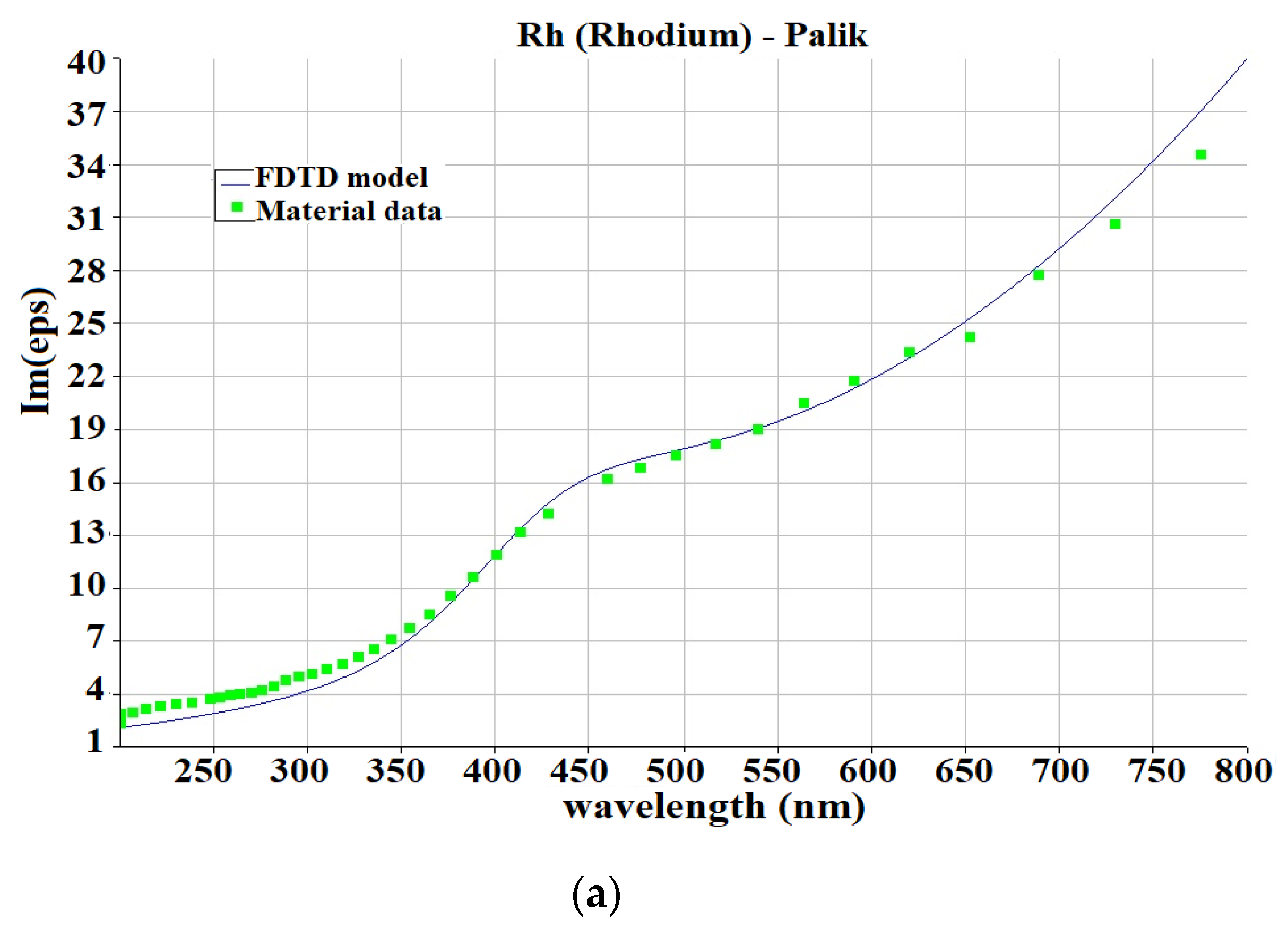
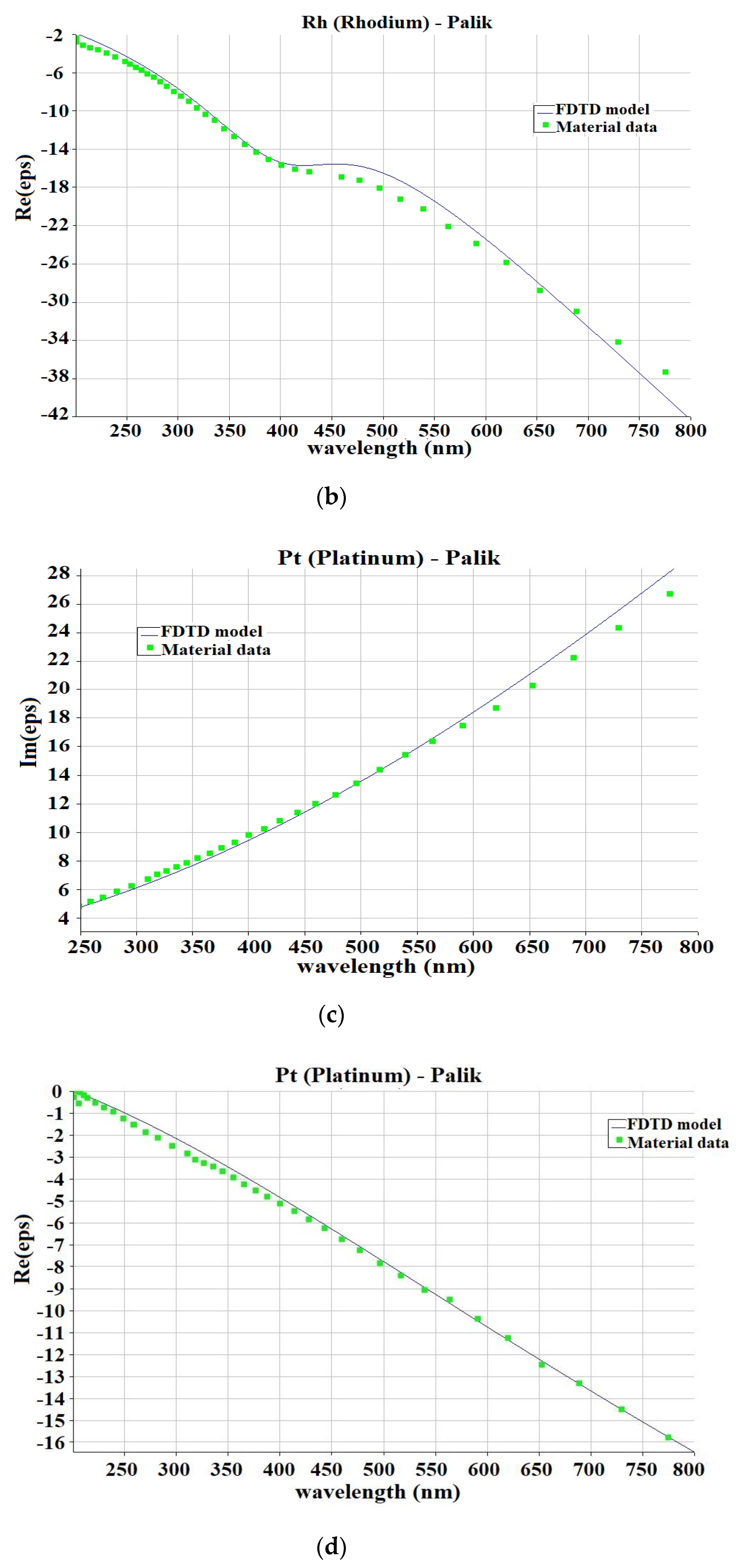
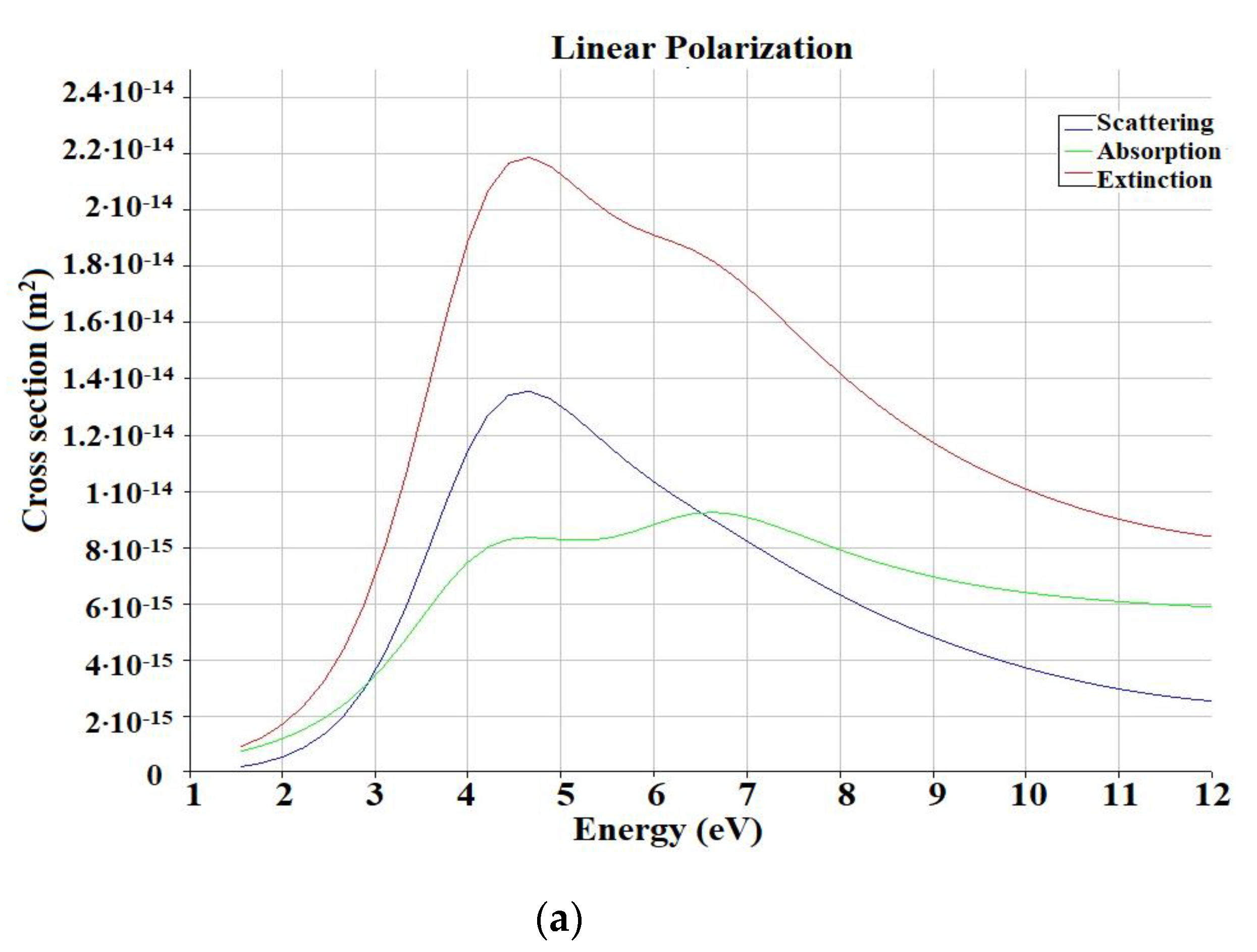
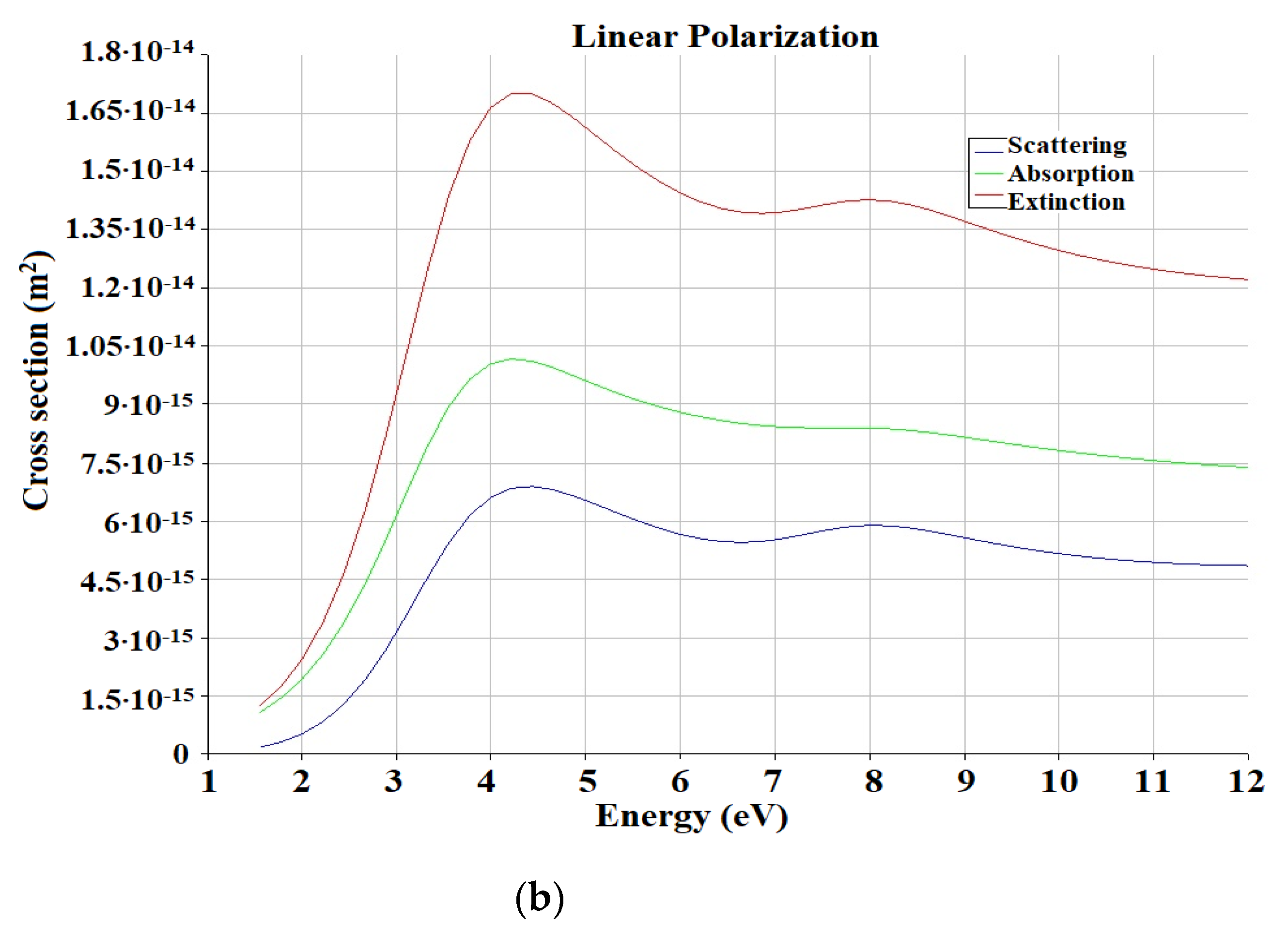
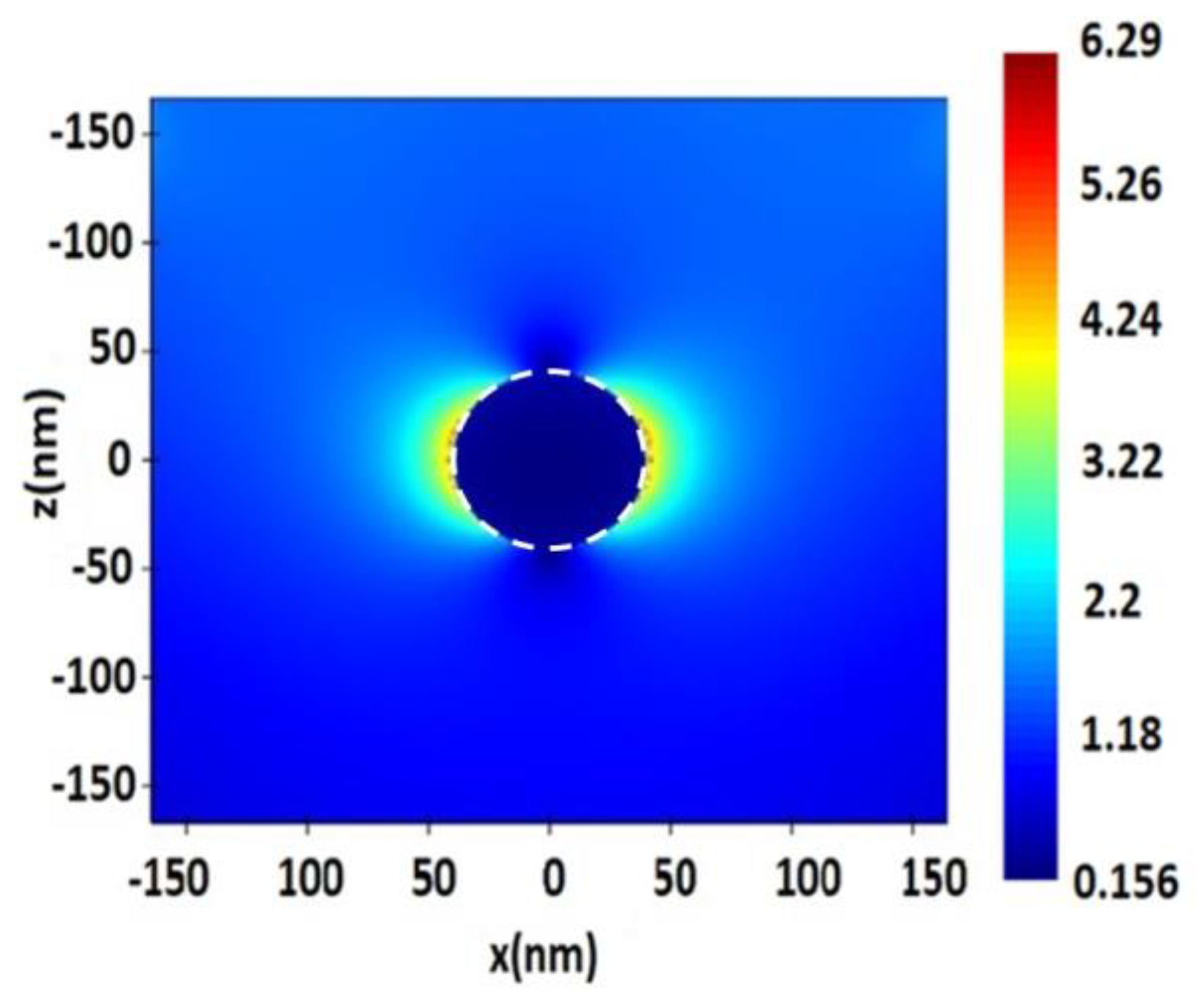
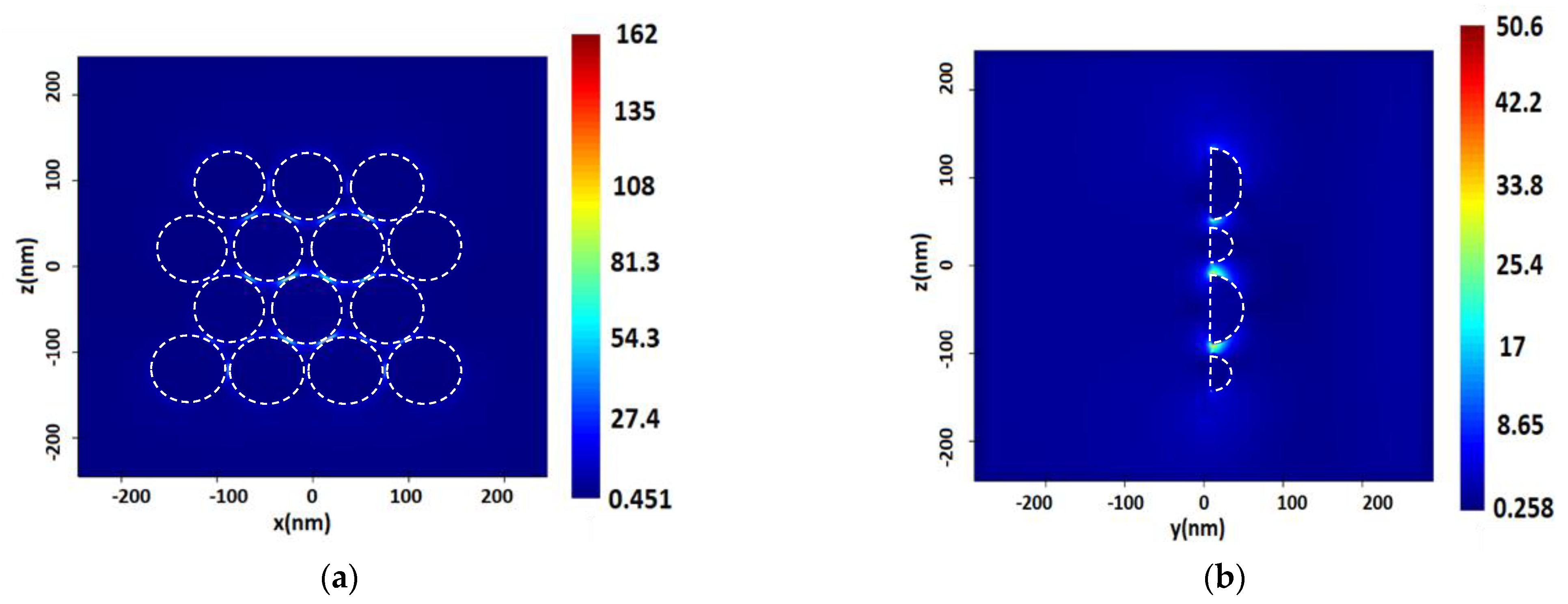
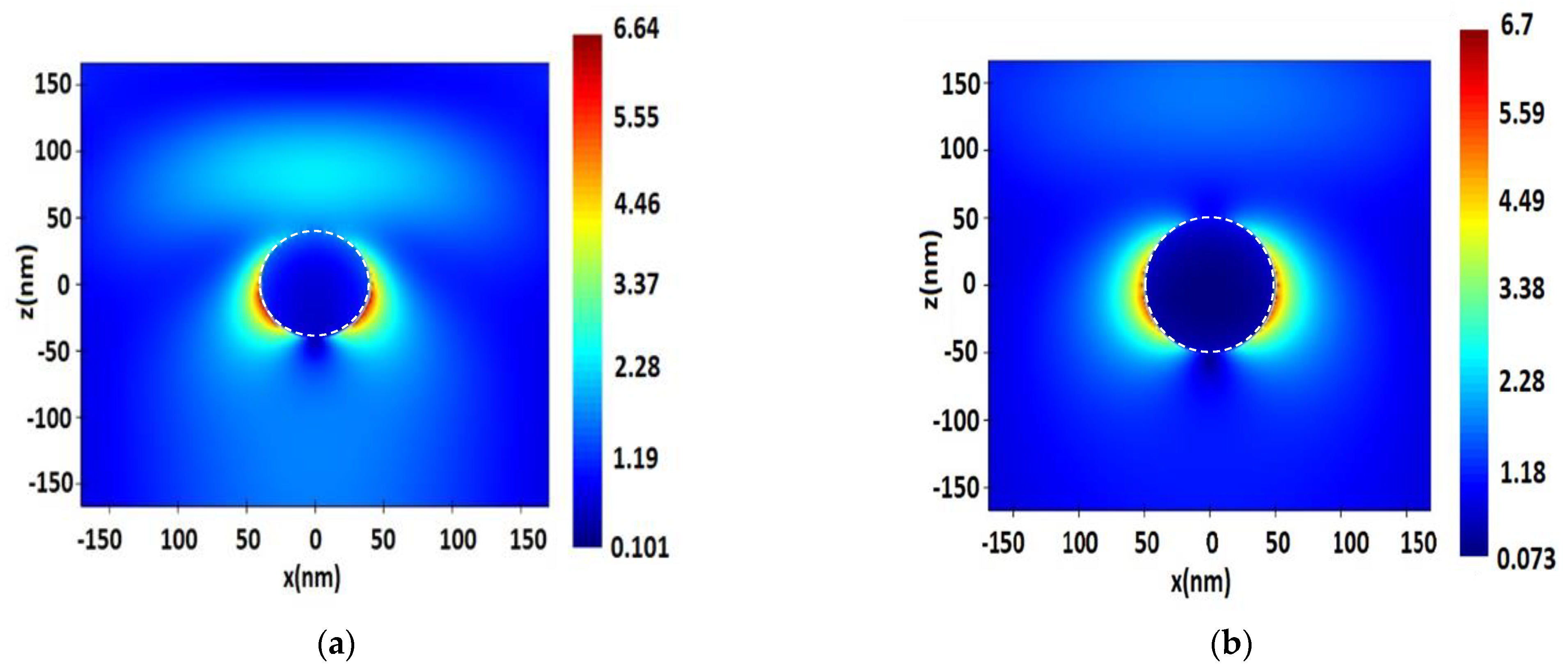
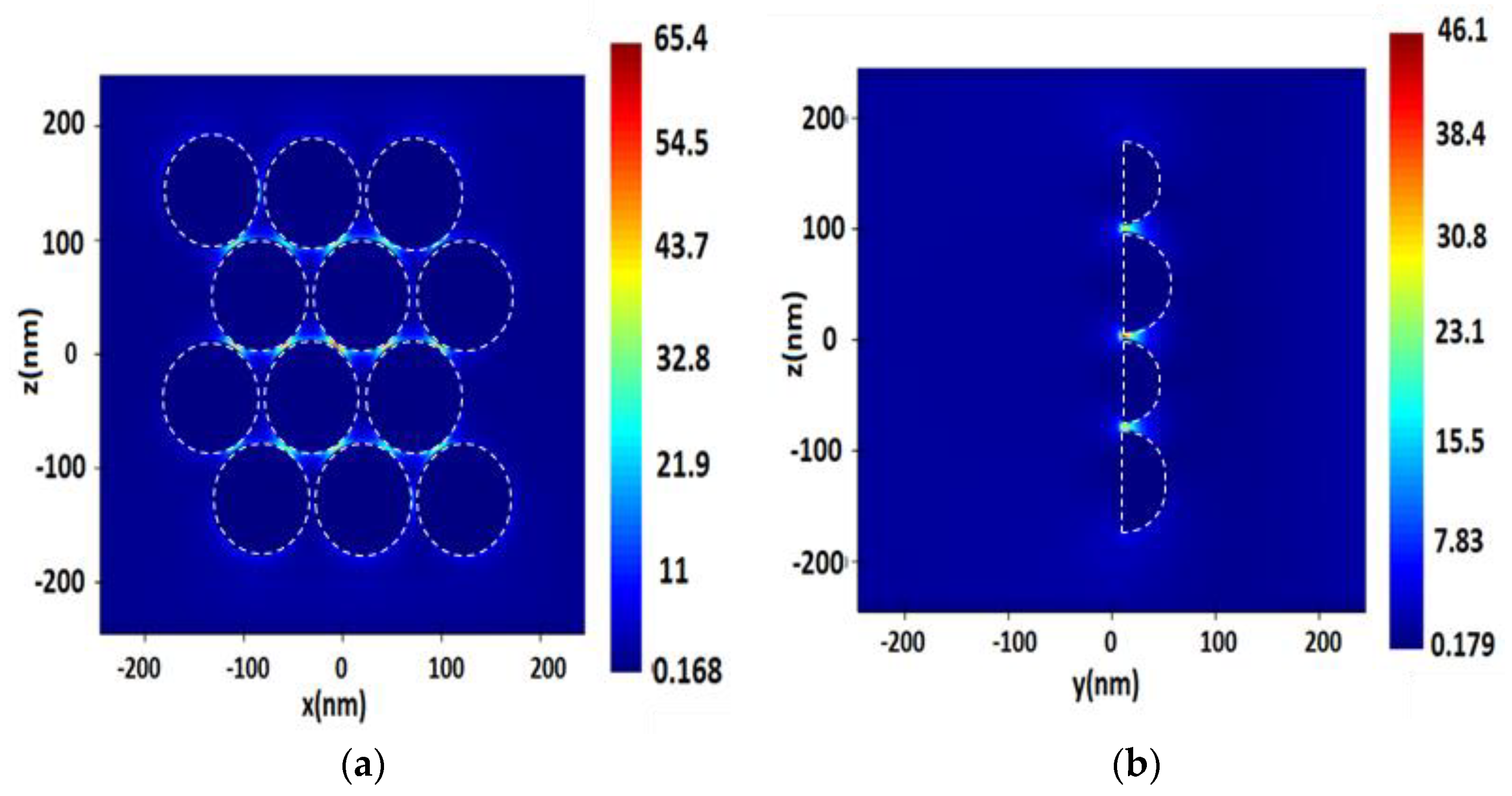
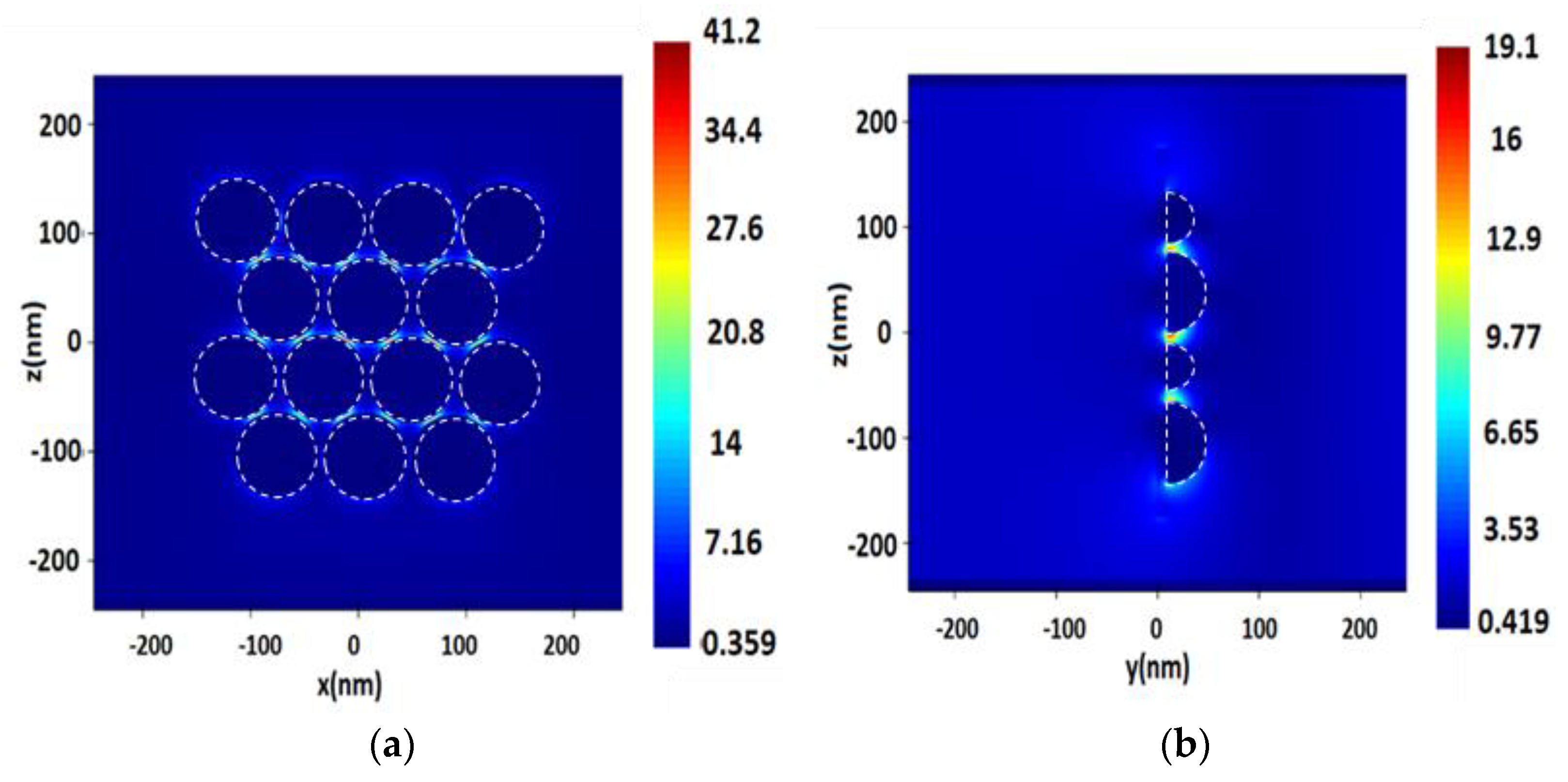
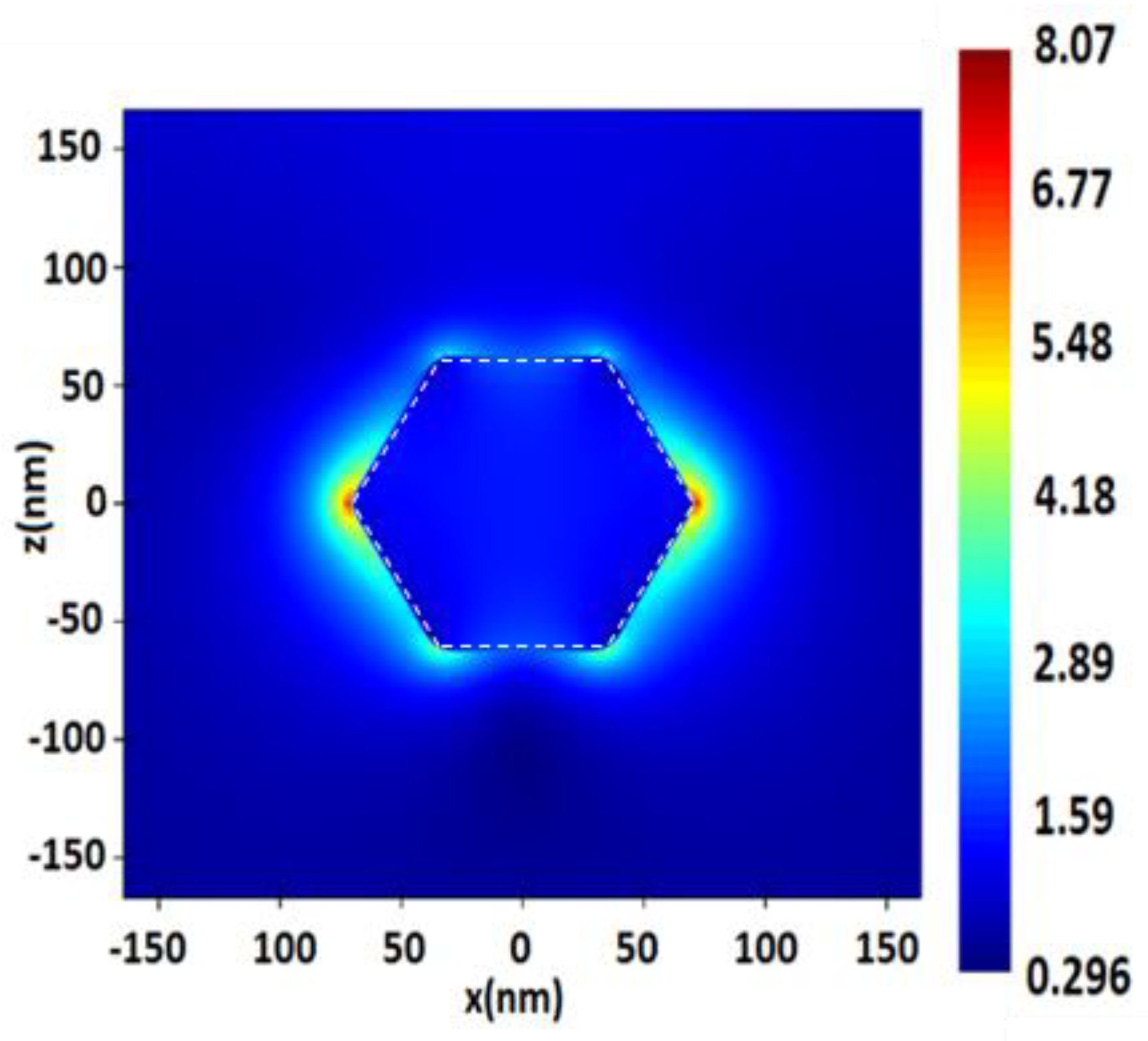
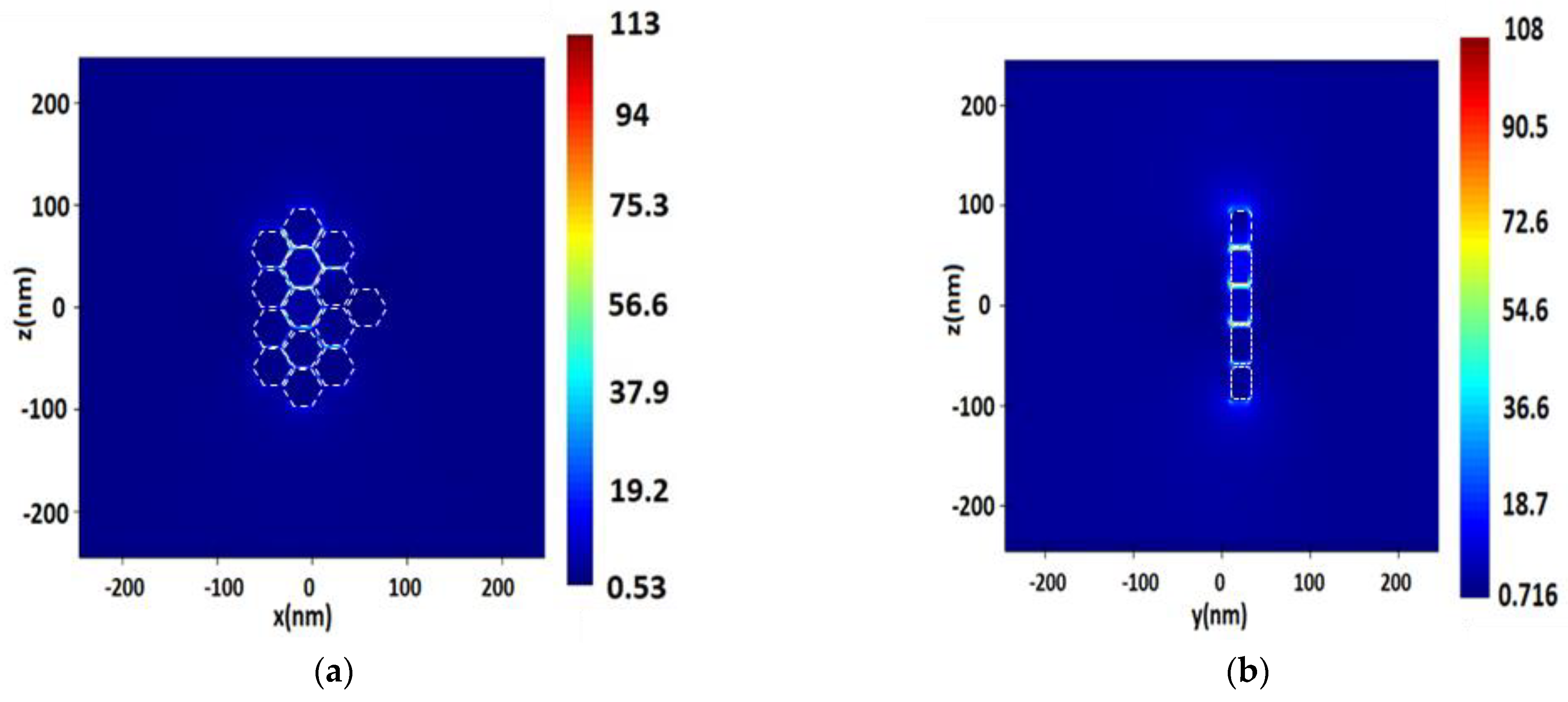
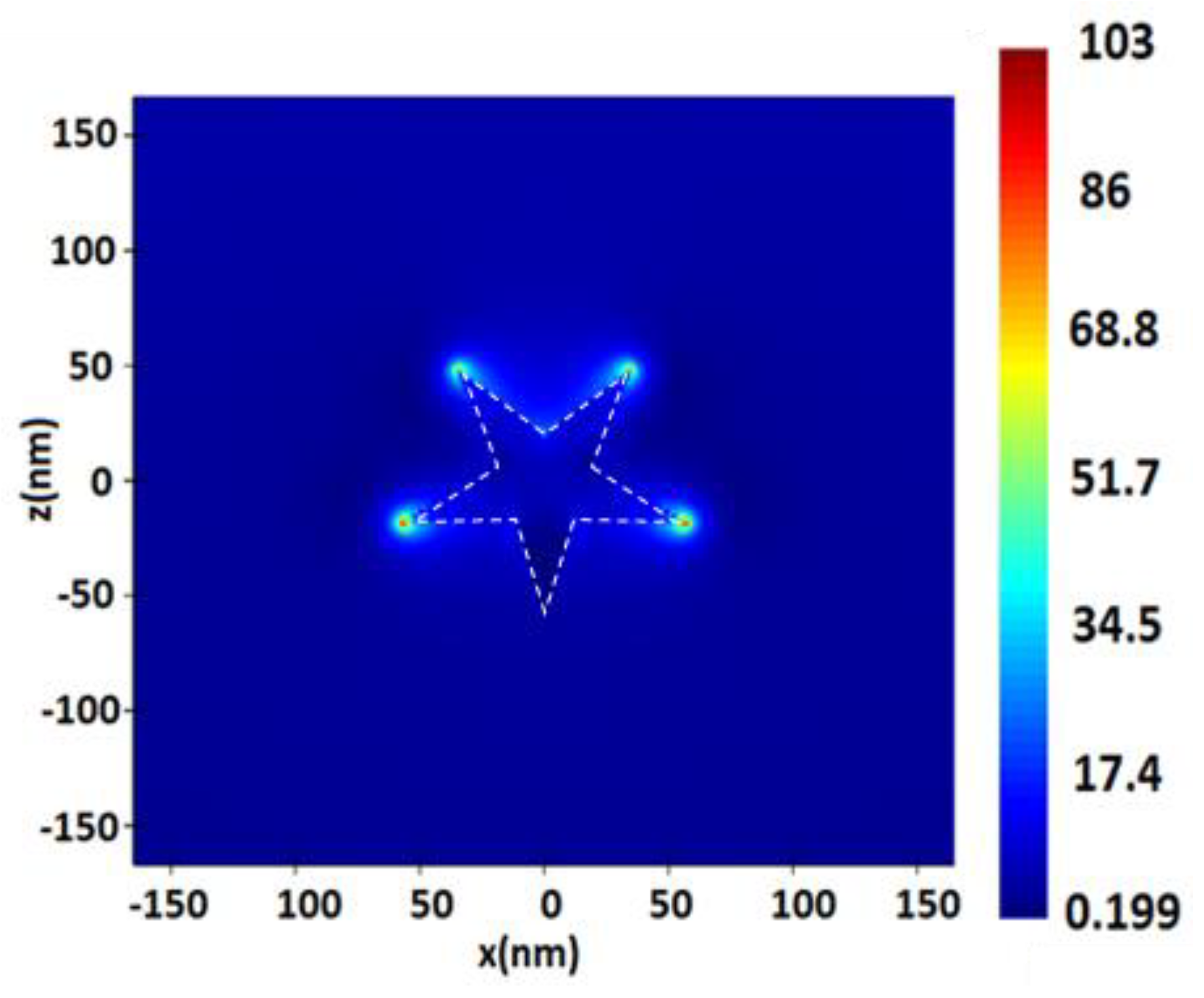

| Excitation Wavelength λ, nm | Structure Type | Re (ε) | Im (ε) |
|---|---|---|---|
| 244 | Rh NPs | −4.64 | 3.62 |
| Pt NPs | −1.12 | 4.69 | |
| 355 | Rh NPs | −12.75 | 7.78 |
| Pt NPs | −3.97 | 8.18 | |
| 532 | Ag NPs | −12.14 | 1.74 |
| 632.8 | Ag NPs | −18.66 | 2.33 |
| Gold NS | −10.8 | 0.795 | |
| 785 | Gold NS | −21.64 | 0.74 |
| Sphere Ag Radius | Excitation Wavelength, nm | |||||
|---|---|---|---|---|---|---|
| 532 | 632.8 | 532 | 632.8 | 532 | 632.8 | |
| Local Maximum of Electric Field E, V/m | SERS Signal Intensity, a.u. | Enhancement Coefficient |E/E0|4 | ||||
| 20 | 14.6 | 4.52 | 1600 | 658 | 2.57·106 | 4.33·105 |
| 30 | 2.76 | 5.25 | 678 | 860 | 4.59·105 | 7.39·105 |
| 40 | 3.43 | 6.29 | 984 | 1300 | 9.69·105 | 1.68·106 |
| 70 | 4.66 | 7.71 | 1030 | 1370 | 1.07·106 | 1.88·106 |
| Hemisphere Ag Radius | L | Excitation Wavelength, —nm | |||||
|---|---|---|---|---|---|---|---|
| 532 | 632.8 | 532 | 632.8 | 532 | 632.8 | ||
| Local Maximum of Electric Field E, V/m | SERS Signal Intensity, a.u. | Enhancement Coefficient |E/E0|4 | |||||
| 20 | 1 | 34.5 | 19.2 | 4.88·106 | 8.54·105 | 2.38·1013 | 7.29·1011 |
| 2 | 33 | 18.1 | 6.61·105 | 5.95·105 | 4.36·1011 | 3.54·1011 | |
| 3 | 31.4 | 17.4 | 3.92·105 | 4.2·105 | 1.54·1011 | 1.76·1011 | |
| 30 | 1 | 58 | 32.1 | 7.6·106 | 1.21·106 | 5.78·1013 | 1.45·1012 |
| 2 | 69.9 | 38.1 | 1.59·106 | 3.03·105 | 2.54·1012 | 9.16·1010 | |
| 3 | 68 | 37.3 | 2.44·106 | 4.28·105 | 5.95·1012 | 1.83·1011 | |
| 40 | 1 | 121 | 63.9 | 1.62·106 | 2.72·105 | 2.62·1012 | 7.37·1010 |
| 2 | 162 | 83.7 | 2.04·106 | 3.74·105 | 4.15·1012 | 1.4·1011 | |
| 3 | 112 | 59.3 | 2.55·106 | 7.03·105 | 6.48·1012 | 4.94·1011 | |
| 70 | 1 | 122 | 59.3 | 7.81·105 | 3.38·105 | 6.1·1011 | 1.15·1011 |
| 2 | 240 | 109 | 3.32·105 | 3.25·105 | 1.1·1011 | 1.05·1011 | |
| 3 | 149 | 68.5 | 3.51·105 | 4.31·105 | 1.23·1011 | 1.86·1011 | |
| Hemisphere Pt Radius | Excitation Wavelength, , nm | |||||
|---|---|---|---|---|---|---|
| 244 | 355 | 244 | 355 | 244 | 355 | |
| Local Maximum of Electric Field E, V/m | SERS Signal Intensity, a,u | Enhancement Coefficient |E/E0|4 | ||||
| 15 | 4.96 | 4.97 | 114 | 4270 | 12.900 | 1.83·107 |
| 20 | 5.25 | 5.26 | 137 | 4880 | 18.900 | 2.38·107 |
| 40 | 6.64 | 6.66 | 221 | 8120 | 49.000 | 6.6·107 |
| 50 | 6.69 | 6.7 | 167 | 7120 | 28.000 | 5.06·107 |
| Sphere Rh Radius | Excitation Wavelength, —nm | |||||
|---|---|---|---|---|---|---|
| 244 | 355 | 244 | 355 | 244 | 355 | |
| Local Maximum of Electric Field E, V/m | SERS Signal Intensity, a,u | Enhancement Coefficient |E/E0|4 | ||||
| 35 | 5.99 | 6.01 | 262 | 7570 | 68.800 | 5.74·107 |
| 40 | 6.64 | 6.66 | 341 | 9500 | 116.000 | 9.02·107 |
| 50 | 6.67 | 6.7 | 245 | 8500 | 60.200 | 7.22·107 |
| 70 | 7.36 | 7.38 | 124 | 4830 | 15.500 | 2.33·107 |
| Hemisphere Pt Radius | L | Excitation Wavelength, —nm | |||||
|---|---|---|---|---|---|---|---|
| 244 | 355 | 244 | 355 | 244 | 355 | ||
| Local Maximum of Electric Field E, V/m | SERS Signal Intensity, a.u. | Enhancement Coefficient |E/E0|4 | |||||
| 15 | 1 | 14.1 | 14.1 | 223 | 2040 | 4.98·104 | 4.18·106 |
| 2 | 16.1 | 16.1 | 293 | 2580 | 8.6·104 | 6.67·106 | |
| 3 | 16.7 | 16.7 | 327 | 2940 | 1.07·105 | 8.66·106 | |
| 20 | 1 | 19.7 | 19.8 | 399 | 1950 | 1.59·105 | 3.81·106 |
| 2 | 22.9 | 22.9 | 565 | 2740 | 3.2·105 | 7.5·106 | |
| 3 | 23.7 | 23.7 | 616 | 3050 | 3.79·105 | 9.28·106 | |
| 40 | 1 | 37 | 37.3 | 1370 | 3850 | 1.48·107 | 4.87·105 |
| 2 | 41.2 | 41.4 | 1960 | 4820 | 2.87·106 | 2.32·107 | |
| 3 | 44.2 | 44.6 | 1960 | 2940 | 3.83·106 | 8.66·106 | |
| 50 | 1 | 37.5 | 37.7 | 1410 | 3720 | 1.98·106 | 1.39·107 |
| 2 | 48.1 | 48.5 | 2130 | 4030 | 5.35·106 | 1.62·107 | |
| 3 | 53.1 | 53.4 | 2820 | 4810 | 7.43·106 | 2.31·107 | |
| Hemisphere Rh Radius | L | Excitation Wavelength, —nm | |||||
|---|---|---|---|---|---|---|---|
| 244 | 355 | 244 | 355 | 244 | 355 | ||
| Local Maximum of Electric Field E, V/m | SERS Signal Intensity, a,u. | Enhancement Coefficient |E/E0|4 | |||||
| 35 | 1 | 16.6 | 16.1 | 787 | 3440 | 6.19·105 | 1.18·107 |
| 2 | 22 | 20.9 | 1140 | 5960 | 1.3·106 | 3.55·107 | |
| 3 | 21.4 | 20.4 | 1290 | 7140 | 1.66·106 | 5.09·107 | |
| 40 | 1 | 44.9 | 41 | 2480 | 14000 | 6.13·106 | 1.97·108 |
| 2 | 52.2 | 48.9 | 3080 | 19600 | 9.46·106 | 3.84·108 | |
| 3 | 54.3 | 51.5 | 3800 | 23100 | 1.44·107 | 5.32·108 | |
| 50 | 1 | 37.5 | 35 | 2440 | 13500 | 5.95·106 | 1.82·108 |
| 2 | 63.4 | 59.4 | 4020 | 15600 | 1.62·107 | 2.42·108 | |
| 3 | 69.9 | 65.4 | 4880 | 20400 | 2.39·107 | 4.16·108 | |
| 70 | 1 | 54 | 50.1 | 2910 | 17800 | 8.48·106 | 3.18·108 |
| 2 | 56.9 | 53.6 | 3690 | 16300 | 1.36·107 | 2.65·108 | |
| 3 | 61 | 57.7 | 3900 | 22300 | 1.52·107 | 4.97·108 | |
| Hexagon Ag Radius | Excitation Wavelength, —nm | |||||
|---|---|---|---|---|---|---|
| 532 | 632.8 | 532 | 632.8 | 532 | 632.8 | |
| Local Maximum of Electric Field E, V/m | SERS Signal Intensity, a.u | Enhancement Coefficient |E/E0|4 | ||||
| 20 | 2.18 | 4.4 | 525 | 645 | 2.75·105 | 4.16·105 |
| 40 | 3.86 | 7.24 | 1440 | 2010 | 2.07·106 | 4.04·106 |
| 50 | 4.89 | 9.13 | 2650 | 3710 | 7.01·106 | 1.38·107 |
| 70 | 8.07 | 14.3 | 6890 | 8840 | 4.74·107 | 7.82·107 |
| Hexagon Ag Radius | L | Excitation Wavelength, , nm | |||||
|---|---|---|---|---|---|---|---|
| 532 | 632.8 | 532 | 632.8 | 532 | 632.8 | ||
| Local Maximum of Electric Field E, V/m | SERS Signal Intensity, a,u. | Enhancement Coefficient |E/E0|4 | |||||
| 20 | 1 | 158 | 88 | 8.92·105 | 3.9·105 | 7.96·1011 | 1.52·1011 |
| 2 | 28.3 | 15.8 | 5.8·105 | 3.77·105 | 3.37·1011 | 1.42·1011 | |
| 3 | 27.2 | 15.4 | 8.15·105 | 3.12·105 | 6.64·1011 | 9.75·1010 | |
| 40 | 1 | 113 | 62.7 | 6.85·105 | 2.17·105 | 4.69·1011 | 4.69·1010 |
| 2 | 210 | 132 | 4.08·105 | 9.09·104 | 1.66·1011 | 8.26·109 | |
| 3 | 73 | 32.1 | 6.21·105 | 1.39·105 | 3.85·1011 | 1.92·1010 | |
| 50 | 1 | 47.4 | 24.3 | 3.68·105 | 1.38·105 | 1.36·1011 | 1.9·1010 |
| 2 | 166 | 86.3 | 2.19·105 | 1.45·105 | 4.81·1010 | 2.1·1010 | |
| 3 | 94.4 | 50.5 | 3.95·105 | 1.52·105 | 1.56·1011 | 2.3·1010 | |
| 70 | 1 | 76.6 | 39.6 | 1.76·105 | 1.45·105 | 3.11·1010 | 2.09·1010 |
| 2 | 160 | 86.6 | 2.18·105 | 7.96·104 | 4.75·1010 | 6.33·109 | |
| 3 | 181 | 95.2 | 1.5·105 | 1.18·105 | 2.25·1010 | 1.4·1010 | |
| Stars Au | Excitation Wavelength, , nm | |||||
|---|---|---|---|---|---|---|
| 632.8 | 785 | 632.8 | 785 | 632.8 | 785 | |
| Local Maximum of Electric Field E, V/m | SERS Signal Intensity, a,u. | Enhancement Coefficient |E/E0|4 | ||||
| Outer radius 30 nm, Inner radius 10 mn, Height 8 nm | 11.9 | 116 | 1060 | 13500 | 1.13·106 | 1.82·108 |
| Outer radius 40 nm, Inner radius 10 mn, Height 8 nm | 8.76 | 17.2 | 982 | 10900 | 9.64·105 | 1.18·108 |
| Outer radius 45 nm, Inner radius 15 mn, Height 8 nm | 22.1 | 25.5 | 1390 | 17600 | 1.92·106 | 3.09·108 |
| Outer radius 50 nm, Inner radius 20 mn, Height 10 nm | 39.9 | 49.1 | 9900 | 2510 | 4.16·106 | 9.8·107 |
| Outer radius 60 nm, Inner radius 20 mn, Height 10 nm | 17.2 | 103 | 1640 | 10600 | 2.68·106 | 1.13·108 |
| Outer radius 65 nm, Inner radius 25 nm, Height 10 nm | 24.8 | 156 | 1870 | 77600 | 3.48·106 | 6.03·109 |
| Outer radius 75 nm, Inner radius 25 nm, Height 10 nm | 23.4 | 40.1 | 3140 | 4.95·105 | 9.84·106 | 2.45·1011 |
| Stars Au | L | Excitation Wavelength, —nm | |||||
|---|---|---|---|---|---|---|---|
| 632.8 | 785 | 632.8 | 785 | 632.8 | 785 | ||
| Local Maximum of Electric Field E, V/m | SERS Signal Intensity, a,u. | Enhancement Coefficient |E/E0|4 | |||||
| Outer radius 30 nm, Inner radius 10 mn, Height 8 nm | 1 | 52.5 | 79.3 | 7540 | 19700 | 5.68·107 | 3.88·108 |
| 2 | 37.9 | 63.4 | 5440 | 11900 | 2.96·107 | 1.42·108 | |
| 3 | 48 | 70.4 | 5900 | 15700 | 3.48·107 | 2.48·108 | |
| Outer radius 40 nm, Inner radius 10 mn, Height 8 nm | 1 | 16.8 | 20.9 | 2530 | 18800 | 6.4·106 | 3.55·108 |
| 2 | 27 | 36.6 | 2450 | 18400 | 6.01·106 | 3.38·108 | |
| 3 | 17.5 | 23.7 | 1650 | 5490 | 2.73·106 | 3.02·107 | |
| Outer radius 45 nm, Inner radius 15 mn, Height 8 mn | 1 | 42.4 | 62.8 | 5570 | 19600 | 3.13·107 | 3.83·108 |
| 2 | 57.2 | 87.3 | 7590 | 23800 | 5.76·107 | 5.67·108 | |
| 3 | 22.4 | 32.5 | 4770 | 36900 | 2.27·107 | 1.36·109 | |
| Outer radius 50 nm, Inner radius 20 mn, Height 10 nm | 1 | 49.1 | 69 | 15,600 | 35400 | 2.45·108 | 1.25·109 |
| 2 | 53.8 | 95.1 | 13,400 | 28800 | 1.79·108 | 8.29·108 | |
| 3 | 37.9 | 53.8 | 18,000 | 27700 | 3.23·108 | 7.7·108 | |
| Outer radius 60 nm, Inner radius 20 mn, Height 10 nm | 1 | 24.3 | 35 | 11,700 | 51300 | 1.36·108 | 2.64·109 |
| 2 | 42.4 | 62.9 | 7880 | 56100 | 6.21·107 | 3.15·109 | |
| 3 | 29.4 | 39 | 7180 | 41100 | 5.16·107 | 1.69·109 | |
| Outer radius 65 nm, Inner radius 25 mn, Hei ght 10 nm | 1 | 61.3 | 87.3 | 13,900 | 1.52·105 | 1.92·108 | 2.32·1010 |
| 2 | 79.8 | 117 | 7130 | 45800 | 5.08·107 | 2.09·109 | |
| 3 | 31.1 | 46.5 | 9690 | 43800 | 9.38·107 | 1.92·109 | |
| Outer radius 75 nm, Inner radius 25 mn, Hei ght 10 nm | 1 | 30.3 | 44.9 | 11,400 | 11000 | 1.29·108 | 1.36·1010 |
| 2 | 34.7 | 42.2 | 9180 | 46710 | 8.42·107 | 2.18·109 | |
| 3 | 27.9 | 36.4 | 11,500 | 23300 | 1.33·108 | 5.42·108 | |
Disclaimer/Publisher’s Note: The statements, opinions and data contained in all publications are solely those of the individual author(s) and contributor(s) and not of MDPI and/or the editor(s). MDPI and/or the editor(s) disclaim responsibility for any injury to people or property resulting from any ideas, methods, instructions or products referred to in the content. |
© 2023 by the authors. Licensee MDPI, Basel, Switzerland. This article is an open access article distributed under the terms and conditions of the Creative Commons Attribution (CC BY) license (https://creativecommons.org/licenses/by/4.0/).
Share and Cite
Zyubin, A.Y.; Kon, I.I.; Poltorabatko, D.A.; Samusev, I.G. FDTD Simulations for Rhodium and Platinum Nanoparticles for UV Plasmonics. Nanomaterials 2023, 13, 897. https://doi.org/10.3390/nano13050897
Zyubin AY, Kon II, Poltorabatko DA, Samusev IG. FDTD Simulations for Rhodium and Platinum Nanoparticles for UV Plasmonics. Nanomaterials. 2023; 13(5):897. https://doi.org/10.3390/nano13050897
Chicago/Turabian StyleZyubin, Andrey Yurevich, Igor Igorevich Kon, Darya Alexeevna Poltorabatko, and Ilia Gennadievich Samusev. 2023. "FDTD Simulations for Rhodium and Platinum Nanoparticles for UV Plasmonics" Nanomaterials 13, no. 5: 897. https://doi.org/10.3390/nano13050897
APA StyleZyubin, A. Y., Kon, I. I., Poltorabatko, D. A., & Samusev, I. G. (2023). FDTD Simulations for Rhodium and Platinum Nanoparticles for UV Plasmonics. Nanomaterials, 13(5), 897. https://doi.org/10.3390/nano13050897





